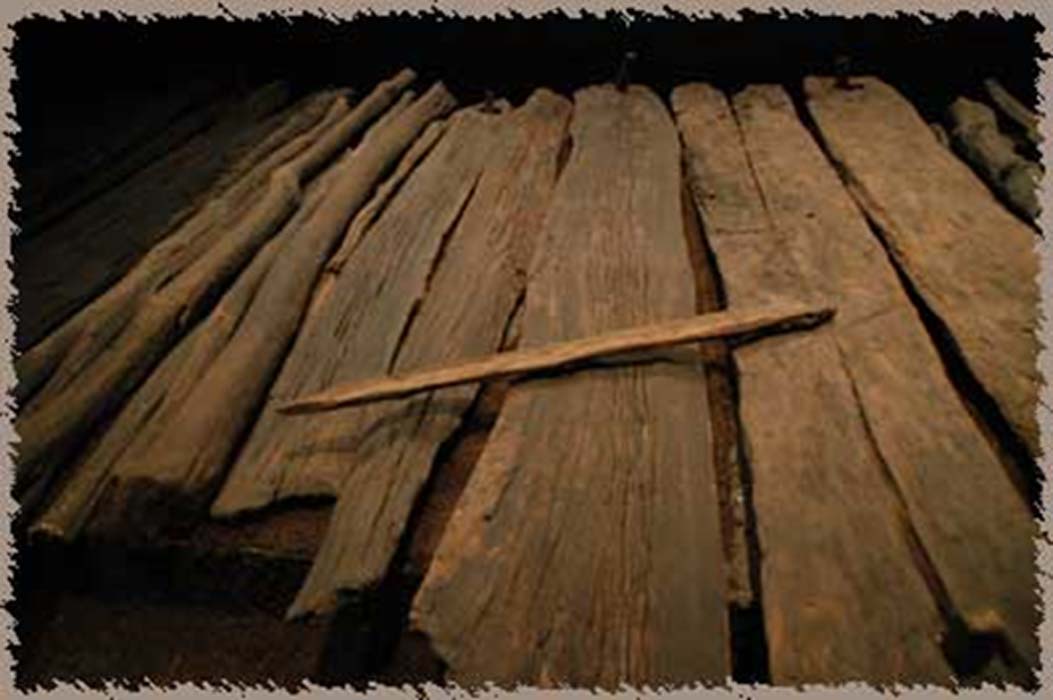Corlea Trackway Holds the Echoes of 2000-year-old Footsteps
The Corlea Trackway (known also in Irish as Bóthar Chorr Liath) is a timber trackway dating to the Iron Age. This ancient trackway is located near Keenagh, a village to the south of Longford, in County Longford, Ireland. The Corlea Trackway was discovered during the 1980s, when it was exposed during the harvesting of peat from the bog. Excavation of the trackway commenced in the following year. Due to the significance of this find, the Corlea Trackway is today on permanent display in a specially built exhibition centre that is conditioned to preserve it in the state it was found.
2166-Year-Old Track
In 1984, workers from the Bord na Móna (which, incidentally, translates into English as ‘Peat Board’) were harvesting peat from a bog in Corlea when they made an unexpected archaeological discovery, namely the Corlea Trackway. This trackway is composed of oak planks resting on a foundation of birch rails, and, based on tree ring dating (known also as dendrochronology) conducted at Queen’s University Belfast, it was determined that the trees used to construct the trackway were felled either in late 148 BC or early 147 BC, which is a period of time that corresponds to the British Iron Age.
- Star-Crossed Lovers? Criminals? Or Strangers? The Mystery of the Windeby Bog Bodies
- Ancient bog body found in Ireland may be Iron Age sacrifice
- Osterby Man Still Has a Great Hairdo Nearly 2,000 Years On!

Detail of Corlea Trackway - County Longford, Ireland. (CC BY-SA 3.0)
Peat Preservation
To date, the Corlea Trackway is the only known example of such an Iron Age trackway in Ireland, hence making it a unique archaeological discovery. It may be said, however, that similar wooden trackways have been discovered in other parts of the British Isles, as well as in continental Europe. The Lindholme Trackway in England, and the Wittmoor Bog Trackway are two such examples. It is interesting to note that these trackways were all discovered in peat bogs, which is an environment that is highly conducive to the preservation of organic remains, including wooden artifacts. In bogs, the acidic conditions create an environment which is low in oxygen content. This prevents the growth of microorganisms, which helps to preserve organic remains, such as wood, leather, and even the soft tissues of humans or animals.
- Ancient Bog Mummies Reveal Secrets of their Identity
- Howling Against the Moon: The Last Wolves of Ireland
- Baltinglass Hill: Ireland’s Forgotten Gobekli Tepi?

The Corlea Trackway (reconstructed boardwalk) in County Longford, Ireland. (CC BY 2.0)
Tracing More Trackway
A year after the Corlea Trackway was unearthed by the Bord na Móna, an archaeological excavation of the trackway, as well as the surrounding area, was carried out under the auspices of the National Monuments Branch of the Office of Public Works. This excavation was directed Professor Barry Raftery of University College Dublin, and continued until 1991. From these excavations, it was discovered that the Corlea Trackway was not the only ancient trackway to have been preserved in the bog. During the first year of the excavation, for instance, four other trackways were uncovered. As another example, another 16 trackways were later found along the western edge of the bog.
Theories of Use
It has been suggested that the Corlea Trackway was made to accommodate wheeled vehicles, such as carts, or even chariots. This is due to the fact that the surface of the trackway is smooth and flat, which would ease the movement of such vehicles. Nevertheless, it is unclear as to how the Corlea Trackway would have been used by the ancients. Some, for instance, have argued that people used the trackway to cross the bog. Others, however, are of the opinion that the trackway allowed people to travel into the bog, where rituals could be carried out. Apart from that, it has also been suggested that the trackway was not in use for a long time before it sank into the peat, which allowed it to be preserved till this day.

Corlea Trackway Visitor Center. (CC BY-SA 2.0)
Corlea Trackway and Bog Culture Exhibition
Finally, due to the unique nature of the Corlea Trackway, an exhibition center was built in 1994. Within this building, which is specially fitted with humidifiers so as to prevent the ancient wood from cracking due to dryness, 18 meters (60 ft) of the Corlea Trackway is on permanent display. Additionally, visitors to the center may learn more about Iron Age trackways, archaeology, and bog culture through the exhibits there. Moreover, a boardwalk, which follows the course of the remaining trackway that is still buried under the bog, was constructed, so as to allow visitors to have a sense of how the Colrea Trackway may have looked during the Ion Age.
Top image: Part of the Corlea Trackway. Credit: Phouka.com
By Wu Mingren
References
County Longford Tourism Office, 2018. Corlea Trackway Visitor Centre. [Online]
Available at: http://www.longfordtourism.ie/see-do/attractions/corlea-trackway-visitor-centre/
Dempsey, J., 2018. Corlea Ancient Trackway. [Online]
Available at: http://www.megalithicireland.com/Corlea%20Trackway.html
Failte Ireland, 2018. Corlea Trackway Visitor Centre. [Online]
Available at: https://www.discoverireland.ie/Arts-Culture-Heritage/corlea-trackway-visitor-centre/582
Harvey, I., 2017. The 2000 Year Old Corlea Trackway – A Wooden Road in Ireland. [Online]
Available at: https://www.thevintagenews.com/2017/04/21/the-2000-year-old-corlea-trackway-a-wooden-road-in-ireland/
Heritage Ireland, 2018. Corlea Trackway Visitor Centre. [Online]
Available at: http://www.heritageireland.ie/en/midlands-eastcoast/corleatrackwayvisitorcentre/
Kaushik, 2016. Corlea Trackway: A 2,000-Year-Old Wooden Road in Ireland. [Online]
Available at: http://www.amusingplanet.com/2016/05/corlea-trackway-2000-year-old-wooden.html
Schorr, F. & Schorr, K., 2005. Corlea Trackway (Togher), Co. Langford. [Online]
Available at: http://www.ancientireland.org/corlea/index.htm
Thompson, C., 2013. The Corlea Trackway. [Online]
Available at: https://storyarchaeology.com/the-corlea-trackway/



















